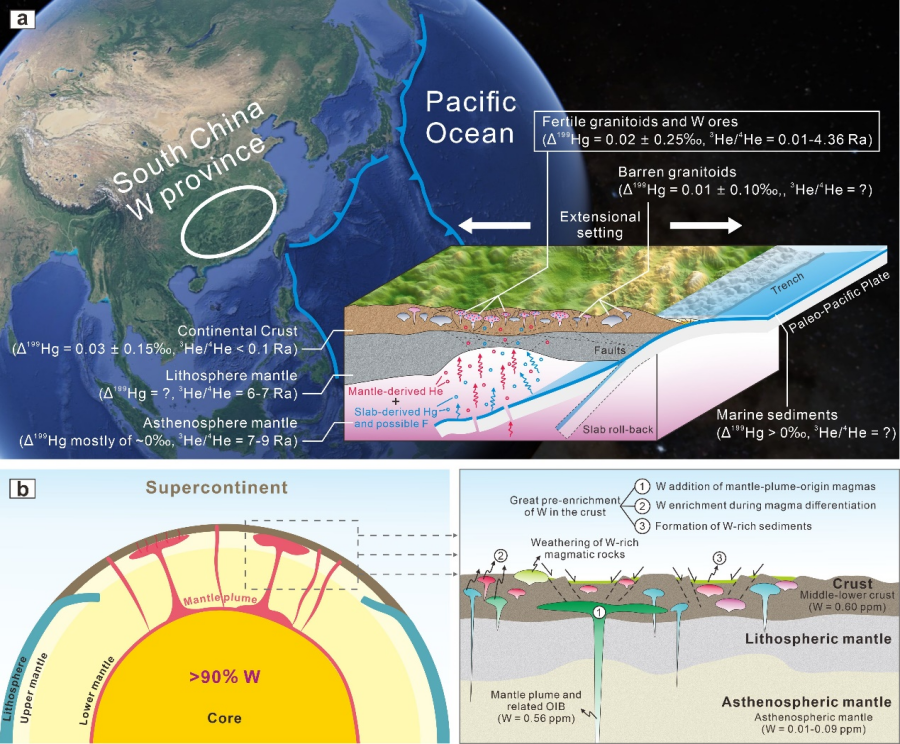Tungsten (W) is a hard, refractory and anti-corrosive metal, and is critical for modern high-tech industries, e.g., the aerospace, military, and computer sectors of the global economy. Despite its uneven global distribution (Fig. 1), most W deposits share some common geological features: (1) strong association with highly evolved, volatile-rich granites; (2) an anatectic origin from metasedimentary rocks for W-fertile granitoids; and (3) occurrence in back-arc or intraplate settings rather than at convergent margins. These features have led to previous models emphasizing a crustal origin for W mineralization. However, He‒Ar isotopic data from W deposits globally indicate a notable mantle involvement in ore-forming fluids, despite crustal signatures in the associated granites. This isotopic decoupling phenomenon between ore minerals and associated granitoids has not been systematically investigated, and thus the role and necessity of mantle activities in W metallogeny remain unclear.
To address the scientific problems, Prof. YANG Jiehua at the Institute of Geochemistry, Chinese Academy of Sciences (IGCAS), under the guidance of Academician HU Ruizhong and Prof. ZHOU Meifu, conducted collaborative research with domestic and international partners. The study employed integrated analyses of Hg‒He‒Ar isotopes in ore minerals and granitoids from representative W deposits in South China, compiled Hg‒He‒Ar‒Sr‒Nd isotopic data for tungsten provinces globally, and applied statistical analysis, geochemical modeling, and machine learning to explore the role and mechanisms of mantle contributions in global W cycling and mineralization. The key findings of this work include:
Intense crust-mantle interaction as a prerequisite for extensive W mineralization: Compiled He‒Ar isotope data indicate significant mantle input in the ore-forming fluids of global W deposits (~10% in W deposits of South China, >40% in W deposits elsewhere). The positive Δ¹⁹⁹Hg anomalies of W-fertile granitoids and long-term Sr‒Nd isotope evolution of mafic rocks in South China demonstrate that the slab roll-back of Paleo-Pacific Plate modified the ancient enriched lithospheric mantle beneath South China, driving intense crust-mantle interaction essential for extensive W mineralization.
Construction of generalized W metallogenic model: Machine learning models distinguish W-fertile granitoids from barren by highly evolved features. Based on the whole-rock geochemistry and Hg‒He‒Ar‒Sr‒Nd data, together with the tectonic distribution of global W deposits, the researchers proposed a generalized W metallogenic model (Fig. 1a) that oceanic-subduction-related extension is more likely to facilitate extensive W mineralization than other geodynamic processes, e.g., continental collision, post-collisional extension, and intracontinental rifting. During this process, the mantle provides heat for inducing slab devolatilization, whereby abundant He‒Ar‒Hg‒(F) are mobilized into the crust and facilitate the high degree of magma differentiation and associated W mineralizing processes.
Establishment of tungsten recycling processes and their relationships with Nuna supercontinent cycle: Compiled Nd model ages (TDM₂) from global W-fertile granitoids and scheelites consistently peak at 1.8–1.2 Ga, coinciding with the assembly and break-up of the Nuna supercontinent. As a moderately siderophile element, core-derived W was likely transported to the crust via mantle plume activities during this period, as supported by W contents and Ru-W isotopic signatures in OIB-like magmatic rocks (Fig. 1b). Significantly, the Cathaysia Block of South China has been recently configured in the intra-continental area of the Nuna supercontinent. It was proposed that the weathering of these W-rich rocks created the pre-enriched crustal basement for later W metallogeny in South China during the Mesozoic.
Evaluation of tungsten endowment for major W provinces and orogens: the researchers compiled Nd isotope data of major W provinces and orogens globally. The comparative analysis shows that accretionary orogens host larger/more W deposits than collisional orogens, despite the latter having higher proportions of W-rich crustal basement. The unique W endowment of South China stems from the combination of high proportion of W-rich crustal basement and intense crust-mantle interaction related to the post-oceanic-subduction extension.
Proposal of data-driven mineral exploration strategy: The data analysis indicates that granitoids with TDM₂ ages of 1.8–1.2 Ga and formation in post-subduction extensional settings are of high potential of W mineralization. Thus, the researchers proposed a data-driven strategy for identifying prospective regions globally: integrating Nd isotope mapping, whole-rock geochemical anomalies (W, Sn, Zr/Hf, Nb/Ta ratios), and machine learning enables future mineral exploration for W resources. The high-potential regions include the Circum-Pacific (Russian Far East, Alaska, and northwestern Canada), Central Asian Orogenic Belt, and eastern Tethyan Belt.

This research was recently published in Communications Earth & Environment, a leading geoscience journal under Nature Publishing Group. This work was financially supported by the National Natural Science Foundation of China (Nos. 42073046, 42372113, 92162323, 42403062), the National Key Research and Development Plan (2023YFC2906401), the International Partnership of the Chinese Academy of Sciences (056GJHZ202205GC), the China Postdoctoral Science Foundation (2024M753200), and the “Light of West China” Program of the Chinese Academy of Sciences.
Article information: Jie-Hua Yang, Jing-Hua Wu, Mei-Fu Zhou*, Rui-Zhong Hu*, Jun-Hong Zhao, Anthony E. Williams-Jones, Qian Hu, Run-Sheng Yin, 2025. Mantle contributions to global tungsten recycling and mineralization. Communications Earth & Environments, https://doi.org/10.1038/s43247-025-02471-2.
Contact
YANG Jiehua
Institute of Geochemistry, Chinese Academy of Sciences
Email: yangjiehua@mail.gyig.ac.cn
(By Prof.YANG Jiehua’s group)